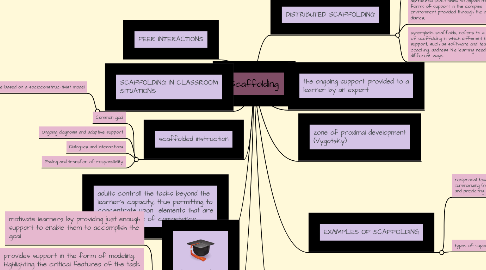Scaffolding
by Anna Doroshenko


1. adults controll the tasks beyond the learner's capacity, thus permitting to concentrate upon elements that are within his range of competence
2. The expert
2.1. motivate learners by providing just enough support to enable them to accomplish the goal
2.2. provides support in the form of modeling, highlighting the critical features of the task
2.3. provides hints and questions that might help learners to reflect
3. scaffolded instruction
3.1. Common goal
3.2. Ongoing diagnosis and adaptive support
3.3. Dialogues and interactions
3.4. Fading and transfer of responsibility
4. SCAFFOLDING IN CLASSROOM SITUATIONS
4.1. are based on a socioconstruc-tivist model
4.1.1. occurs in a rich social context, marked by interaction, negotiation, articulation, and collaboration
4.1.2. support is provided in a paper or software tool, classroom activities
5. PEER INTERACTIONS
6. the ongoing support provided to a learner by an expert
7. zone of proximal development (Vygotsky)
8. EXAMPLES OF SCAFFOLDING
8.1. reciprocal teaching: self-directed summarizing (review), questioning, clarifying, and predicting
8.2. types of support
8.2.1. recruiting the child's interest
8.2.2. reducing the degrees of freedom by simplifying the task
8.2.3. maintaining direction
8.2.4. highlighting the critical task features
8.2.5. controlling frustration
8.2.6. demonstrating ideal solution paths

